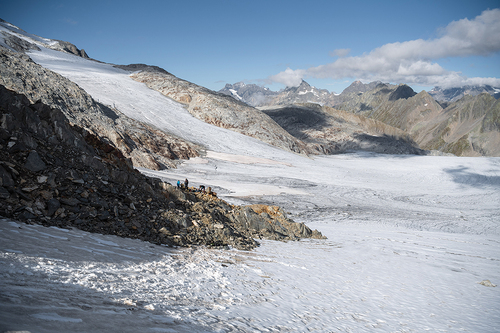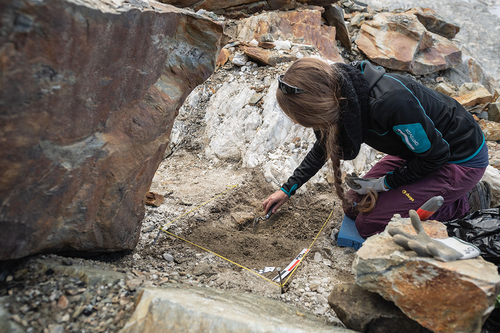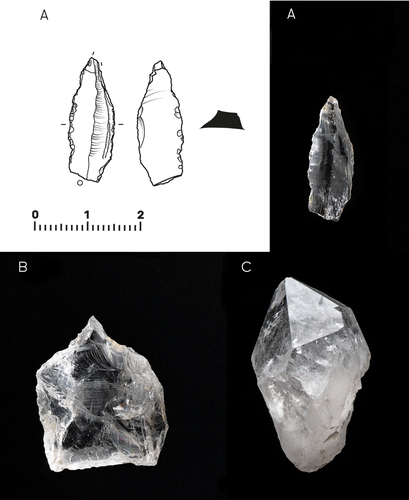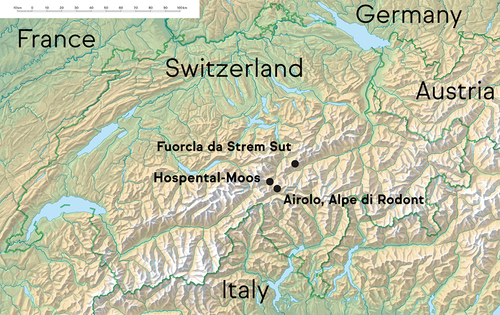Abstract
The retreating Brunifirn glacier in the Alps of central Switzerland exposed a rock crystal extraction site exploited during the Early and Late Mesolithic. It has yielded organic objects preserved in the ice as well as rock crystal and quartz extraction waste, knapping debris, and tools.
INTRODUCTION
During the winter of 2013, local crystal hunter (‘Cavacristallas’ or ‘Strahler’ as they are known in Rumantsch and Swiss German resp.) Heinz Infanger discovered a promising quartz vein recently exposed by the retreating Brunnifirn glacier. The site (2817 m a.s.l.) is situated at the glacier’s western end near the Fuorcla da Strem Sut pass (or ‘Untere Stremlücke’), Silenen, Canton Uri (). When discovered, the vein was only partly visible above the retreating glacier. Since the glacier has lost at least 15 m in height (). When first inspected by archaeologists, the entire quartz vein was exposed and Infanger had, while exploiting the vein, moved most of the then visible archaeological material.
Fig. 2. Fuorcla da Strem Sut above the Brunnifirn, during the Sept. 2020 excavation. @Valentin Luthiger/Institut Kulturen der Alpen.

The geologically crystalline central Swiss Alps has a long tradition of crystal hunting (‘Strahlen’). Retreating glaciers are now exposing important new grounds of interest to both archaeologists and crystal hunters. The Fuorcla da Strem Sut is the first known Mesolithic glacial site in the Alps and the first quartz/rock crystal extraction site in the Swiss Alps absolutely dated to this period. It evidences the potential for Mesolithic archaeology of the alpine and nival zones and especially of glacier/ice patch sites, which may preserve organic material. This rarely survives in other alpine contexts. The site must have been rapidly covered by firn and ice after its last known use around 5900 BC and largely remained so until its rediscovery. Although the taphonomy of many ice sites in the Alps is at least partly unknown in detail, many sites consist of finds preserved in ice patches or glaciers after having been deposited on them (e.g. Pilø et al. Citation2021, p. 4). The Fuorcla da Strem Sut site is a rare instance of a complete site being covered and left undisturbed by a growing glacier. The good preservation is probably aided by being situated at the top of the glacier’s accumulation zone. Rates of warming in Switzerland are currently double global average rates (Zubler et al. Citation2019, pp. 46, 55). The need to adapt to this changing landscape and the long and lively traditions of crystal hunting in central and southern Switzerland make this site relevant to current alpine society.
SITE HISTORY
The ‘Strahler’s’ work exposed a collection of quartz and rock crystal sherds as well as two antler beams. The finds were reported to the local archaeological authorities, and one of the antler pieces and subsequently discovered fragments of wood were dated () (Reitmaier et al. Citation2016, pp. 134–136). After an initial documentation in 2015 and subsequent collection of material by the Archaeological Service of Grisons in 2017, the Service of historical monuments and archaeology, Canton of Uri staged a three-day excavation in September 2020.
During the one-day visit in October 2017, ~250 kg of material was excavated and collected. After wet-sieving (4 mm) 87 litres of material remained to be sorted and described. Subsequently, 13 litres of material were described. Of these, 31% (4 litres) were classified as artefacts, incl. 41 retouched pieces. The 2020 excavation yielded 976 kg (or 700 litres; after wet-sieving [3 mm]) of lithic material from an excavated area of 5.76 m2 (). The 2020 material is in the process of being sorted and described.
Fig. 4. The site under excavation, 2020. In the background the quartz vein discovered by Heinz Infanger. @Valentin Luthiger/Institut Kulturen der Alpen.

On- and off-site interviews with Heinz Infanger as well as the 2020 excavations confirmed that he moved most if not all find-bearing sediment away from the vein, depositing it on the newly exposed rock outside it (Reitmaier et al. Citation2016, pp. 136, 140). Hence, none of the lithic materials we have gathered is stratified. However, it has not been moved far, and first analyses show it not to have suffered much post-depositional damage.
PRELIMINARY RESULTS
Analyses of ~1.65% sieving residue (13 litres) confirm the presence of extraction waste, debitage and tools, including many unworked flakes, bladelets and blades, which can be typologically dated to the Mesolithic. The lithic material analysed thus far is made on clear rock crystal of mostly good quality as well as some quartz. Although other quartz varieties, including smoky quartz (‘Rauchquarz’) of very good quality, are available in the region.
Besides five crystal points, 38 other quartz crystal fragments have been recorded. The majority of the 31 studied nuclei are multi-directional. In addition to this production waste, a wide range of tools has so far been recovered. Three scrapers, a notched blade and notched bladelet, 22 retouched blades/bladelets (including 11 fragments), as well as a denticulated blade fragment were found. Although borers are common in contemporary assemblages, the high number of borers recovered here, eight (including two fragments), is notable (). Many of the blades’ and bladelets’ striking platforms are flat and ~33% show natural crystal surface. One point with bilateral dorsal retouch shows strong similarities to points known from southwestern Switzerland and beyond, dating to the first half of the eighth millennium BC. Another bilaterally retouched blade with broken point could be a similar point, but its typological attribution is less certain. These so-called ‘Ogensspitzen’ demonstrate that the site was used between ~8000–7500 BC, which seems to be confirmed by the dominant platform shapes (Bassin Citation2020, pp. 331–332). After this first phase of use during the Early Mesolithic, radiocarbon dates of organic finds show a renewed use at 6000–5800 BC during the Late Mesolithic (). Further analyses of the lithic material will be able to show whether the site was exploited continuously or whether there were single, separate periods of use over a few thousand years.
Fig. 5. Fuorcla da Strem Sut, rock crystal tools. A) bi-laterally retouched point; B) borer; C) quartz crystal unworked. Scale: 2 cm Photos Valentin Luthiger/Institut Kulturen der Alpen, drawing Marcel Cornelissen.

The relatively high proportion of primary blades suggest these were left on site. Better quality blades without natural crystal surface were perhaps more often carried away and/or used to produce tools, as relatively few of these have been recovered. Preliminary analyses suggest that, although tools were made on flakes as well as on blades/bladelets produced on mostly multi-directional cores, finished tools are morphologically similar to those in contemporary assemblages from the Swiss (Pre-)Alps made on raw materials such as flint, radiolarite and fine-grained quartzite (Nielsen Citation2009, Cornelissen and Reitmaier Citation2016).
Assemblages from nearby Mesolithic occupation sites consist almost exclusively of rock crystal artefacts, e.g. the Early Mesolithic assemblage from Airolo-Alpe di Rodont (Hess et al. Citation2010) and the Late Mesolithic assemblage from Hospental-Moos (Auf der Maur and Cornelissen Citation2014). This is also the case at sites on the northern slopes of the main alpine ridge between Italy and Switzerland (Fontana et al. Citation2000, Curdy et al. Citation2003, Crotti et al. Citation2004). Rock crystal artefacts are also common in other Mesolithic contexts in the Swiss (Pre-)Alps, but they often represent only a small part of the lithic assemblages (Nielsen Citation2009, Cornelissen and Reitmaier Citation2016). With Fiescheralp in the Canton of Wallis and Riepenkar, Austria, two further rock/quartz crystal extraction sites from the Alps are known. Both seem to have been exploited during the Mesolithic and Neolithic (Leitner and Bachnetzer Citation2011, Hess et al. Citation2021).
ORGANIC FINDS
Organic artefacts seldom survive in alpine soils. Glaciers and ice patches thus provide rare preservational conditions. A red deer (Cervus elaphus) antler beam () with possible traces of use is postulated as having been used in the extraction of quartz crystals. Further detailed analyses of the antler artefact are to be carried out as part of the ongoing Bergeisprojekt (see below). A second beam of roe deer (Capreolus capreolus) antler disintegrated as it defrosted and could not be studied in detail. Fragments of Swiss stone pine (Pinus cembra) were also dated to the beginning of the sixth millennium BC () (Reitmaier et al. Citation2016). Although the treeline would have been higher during the Late Mesolithic use of the site, it did not reach the site (Küttel Citation1990, Renner Citation2014, pp. 25–28). Besides, the site would likely have been surrounded by glaciers (Dieleman et al. Citation2018). The pieces of wood can thus be expected to have been brought in anthropogenically, either as parts of tools or as fuel.
Fig. 6. Red deer (Cervus elaphus) antler beam from the Fuorcla da Strem Sut. @G. Perissinotto/Archäologischer Dienst Graubünden.

First impressions suggest typological and technological similarities with lithic assemblages from the southern and western Alps and show that the site was not only visited during the Late Mesolithic but also in the Boreal. Although precise data on the Brunnifirn are lacking still and conditions and levels of glaciation varied locally, it is expected alpine glaciers during the site’s use would have been smaller than today (Hormes et al. Citation2001, Ivy-Ochs et al. Citation2009).
DISCUSSION
The lithic assemblage from this extraction site provides insights into the technical and socio-economic aspects of lithic raw-material procurement and especially that of rock crystal/quartz in the Swiss Alps during the Mesolithic. Furthermore, it will enhance our understanding of the technology of production of rock crystal/quartz tools and the role these materials played in Mesolithic society. Lastly, combined with glaciological modelling and geological research it will give insights into landscape development and hitherto little understood early Holocene anthropogenic use of the Swiss Alps.
The site shows that glaciers and ice patches of the Alps are a potentially rich and underestimated archaeological archive for the Mesolithic. Furthermore, it shows that retreating glaciers in the Alps might uncover complete sites dating from before the Atlantic period. A research and public archaeology project (the Bergeisprojekt) started in mid-2021 at the Institut ‘Kulturen der Alpen’, Altdorf. It focuses on further investigation of this site and other assemblages from the cantons of Uri and Valais and includes further field survey, carried out with the Service of historical monuments and archaeology, Canton of Uri and the Archaeological Service of Grisons. Besides archaeological research, the project’s second equally important goal is to increase awareness of the deep cultural history of the Alps and of the use of rock crystal. It also aims to increase awareness of potential finds in/near glaciers and ice patches among the local population and amongst those regularly active in the mountains, e.g. mountaineers, hikers, crystal hunters and hunters. Ultimately, we hope to encourage the public to notify archaeological authorities in case of finds. The project thus aims to place the prehistoric past of the Alps, including its social and climatic dynamics, within current alpine society and its lively cultural traditions and changing climate.
ACKNOWLEDGEMENTS
The authors thank Heinz Infanger for welcoming us to his ‘Kluft’ and the Archäologischer Dienst Graubünden, the Abteilung Denkmalpflege und Archäologie, Kanton Uri and Institut ‘Kulturen der Alpen’ for their initiatives and support. We also thank the reviewer for their thoughtful remarks. Last but not least we, of course, thank the field teams.
DISCLOSURE STATEMENT
No potential conflict of interest was reported by the author(s).
Additional information
Funding
REFERENCES
- Auf der Maur, C., and Cornelissen, M., 2014. Die spätmesolithische und bronzezeitliche Fundstelle Hospental-Moos. Ein Einblick in das urgeschichtliche Urserntal. Historisches Neujahrsblatt, 68 (103), 37–84.
- Bassin, L., 2020. Le Second Mésolithique du Plateau suisse au Nord du Jura (6600–5000 av. J.-C.). Traditions, innovations et mutations dans les industries lithiques des derniers chasseurs-cueilleurs et des premiers agriculteurs-éleveurs. Archéologie Fribour-geoise/Freiburger Archäologie 27. Fribourg: Service archéo-logique de l’État de Fribourg.
- Cornelissen, M., and Reitmaier, T., 2016. Filling the gap: recent Mesolithic discoveries in the central and south-eastern Swiss Alps. Quaternary International, 423, 9–22. doi:https://doi.org/10.1016/j.quaint.2015.10.121
- Crotti, P., Curdy, P., and Leuzinger, U., 2004. La région du Simplon, (Valais) du Mésolithique à l’époque romaine, campagne de prospection 2003. Annuaire de la Société suisse de préhistoire et d’archéologie, 87, 271–278.
- Curdy, P., Leuzinger-Piccand, C., and Leuzinger, U., 2003. Zermatt Alp Hermettji et les cols secundaires du Valais. In: M. Besse, L.-I. Stahl-Gretsch, and P. Curdy, eds. ConstellaSion. Hommage à Alain Gallay. Cahiers d’archéologie romande 95. Lausanne, 73–88.
- Dieleman, C., et al., 2018. Reconsidering the origin of the Sedrun fans (Graubünden, Switzerland). E&G Quaternary Science Journal, 67, 17–23. doi:https://doi.org/10.5194/egqsj-67-17-2018
- Fontana, F., Guerrschi, A., and Vullo, N., 2000. Le site mésolithique de l’Alpe Veglia (Alpi Lepontie, Italia). Analyse techno-typologique et spatiale. In: P. Crotti, ed. Méso ´97, Actes de la Table ronde “Epipaléolithique et Mésolithique”. Cahiers d´Archéologie Romande, 81. Lausanne, 259–265.
- Hess, T., et al. 2010. Leventina – prähistorische Siedlungslandschaft. Jahrbuch Archäologie Schweiz, 93, 173–192.
- Hess, T., et al. 2021. A Prehistoric rock crystal procurement site at Fiescheralp (Valais, Switzerland). Lithic Technology, 46 (3), 209–220. doi:https://doi.org/10.1080/01977261.2021.1899626
- Hormes, A., Müller, B.U., and Schlüchter, C., 2001. The Alps with little ice: evidence for eight Holocene phases of reduced glacier extent in the Central Swiss Alps. The Holocene, 11 (3), 255–265. doi:https://doi.org/10.1191/095968301675275728
- Ivy-Ochs, S., et al. 2009. Latest Pleistocene and Holocene glacier variations in the European Alps. Quaternary Science Reviews, 28 (21–22), 2137–2149. doi:https://doi.org/10.1016/j.quascirev.2009.03.009
- Küttel, M., 1990. The subalpine protective forest at Urserental - an inelastic ecosystem. Botanica Helvetia, 100 (2), 183–197.
- Leitner, W., and Bachnetzer, T. 2011. Steinzeitliche Gewinnung von Bergkristall in den Tuxer Alpen. In: K. Oeggl, et al, eds. Die Geschichte des Bergbaus in Tirol und seinen angrenzenden Gebieten. Proceedings zum 5. Milestone-Meeting des SFB-HiMAT vom 7.–10.10.2010 in Mühlbach. Innsbruck: Innsbruck university press, 193–197.
- Nielsen, E., 2009. Paläolithikum und Mesolithikum in der Zentralschweiz. Mensch und Umwelt zwischen 17000 und 5500 v.Chr. Archäologische Schriften Luzern 13. Luzern: Kantonsarchäologie Luzern.
- Pilø, L., et al. 2021. On a mountain high: finding and documenting glacial archaeological sites during the Anthropocene. Journal of Field Archaeology, 47 (3), 149–163. doi:https://doi.org/10.1080/00934690.2021.2012330
- Reitmaier, T., et al., 2016. Spätmesolithischer Bergkristallabbau auf 2800 m Höhe nahe der Fuorcla da Strem Sut (Kt. Uri/Graubünden/CH). Archäologisches Korrespondenzblatt, 46 (2), 133–148.
- Renner, F., 2014. Landschafts- und Waldgeschichte des Urserntals. Historisches Neujahrsblatt, 68 (103), 11–36.
- Zubler, E., Bader, S., and Schlegel, T., 2019. Klimareport 2019. Bundesamt für Meteorologie und Klimatologie. Bern: MeteoSchweiz.


